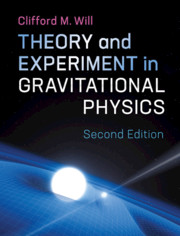Book contents
- Frontmatter
- Dedication
- Contents
- Preface
- Acknowledgments
- 1 Introduction
- 2 The Einstein Equivalence Principle
- 3 Gravitation as a Geometric Phenomenon
- 4 The Parametrized Post-Newtonian Formalism
- 5 Metric Theories of Gravity and Their Post-Newtonian Limits
- 6 Equations of Motion in the PPN Formalism
- 7 The Classical Tests
- 8 Tests of the Strong Equivalence Principle
- 9 Other Tests of Post-Newtonian Gravity
- 10 Structure and Motion of Compact Objects
- 11 Gravitational Radiation
- 12 Strong-Field and Dynamical Tests of Relativistic Gravity
- References
- Index
10 - Structure and Motion of Compact Objects
Published online by Cambridge University Press: 07 September 2018
- Frontmatter
- Dedication
- Contents
- Preface
- Acknowledgments
- 1 Introduction
- 2 The Einstein Equivalence Principle
- 3 Gravitation as a Geometric Phenomenon
- 4 The Parametrized Post-Newtonian Formalism
- 5 Metric Theories of Gravity and Their Post-Newtonian Limits
- 6 Equations of Motion in the PPN Formalism
- 7 The Classical Tests
- 8 Tests of the Strong Equivalence Principle
- 9 Other Tests of Post-Newtonian Gravity
- 10 Structure and Motion of Compact Objects
- 11 Gravitational Radiation
- 12 Strong-Field and Dynamical Tests of Relativistic Gravity
- References
- Index
Summary
We discuss the structure of compact bodies – neutron stars and black holes – in metric theories of gravity. We give a recipe for calculating the structure of such bodies, assumed to be non-rotating for simplicity, in generic metric theories, and then describe the results of calculations in specific theories. Turning to the motion of compact bodies, we develop the modified Einstein-Infeld-Hoffmann (EIH) framework, a generalization of the post-Newtonian N-body Lagrangian to systems containing one or more compact bodies, introducing parameters that may depend upon both the theory of gravity and the internal structure of each body. We analyse a number of observable effects in binary systems containing compact bodies and obtain their dependences on these parameters. The modified EIH parameters are calculated in a number of theories of gravity, including general relativity, scalar-tensor theories and Einstein-Aether/Khronometric theories.
Information
- Type
- Chapter
- Information
- Theory and Experiment in Gravitational Physics , pp. 206 - 231Publisher: Cambridge University PressPrint publication year: 2018
